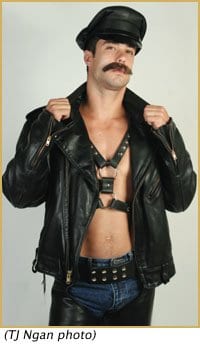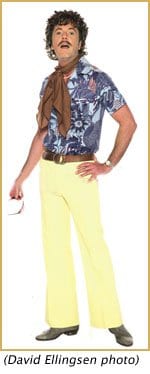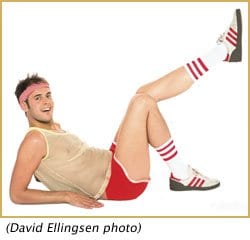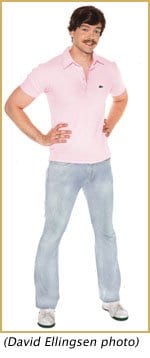As Vancouver gears up for Pride this weekend, check out Xtra West’s interactive tour of the city’s queer history!
- Click on any pink marker to view details about that location
- In the pop-up box, click the green down arrow to view the full location description
- Zoom in and out using the + and – buttons on the left side to see pink markers more clearly
Though the rainbow-adorned Davie Village now beats proudly and openly as the heart of gay Vancouver, it wasn’t always so.
Bars, clubs, bathhouses and other gay spaces only began congregating on Davie St in the early 1980s. Before that, they quietly dotted the streets of the downtown core, concentrated particularly on and around Richards and Seymour Sts, between Robson and the Granville Bridge.
In was into this world that Don Hann stepped in the early 1970s.
Like many young gay men and lesbians at the time, Hann moved to Vancouver in search of others like himself. He soon settled in the nearby, residential West End, which was already emerging as Vancouver’s gay ghetto.
Finding the bars meant finding himself.
“These public spaces gave me a vision of being part of a much larger community,” he says. “This sexual orientation was not only mine.”
Until he discovered the bars, Hann lived alone, isolated and closeted. In an age when homosexuality was barely legal and society made no effort to disguise its disgust, those early gathering spaces gave him a place to openly connect with other gays and lesbians, to develop a shared sense of identity, and to celebrate rather than hide his sexuality.
They gave him a chance to be free.
To this day, Hann cherishes the memories of “growing up as a gay person” in those bars, clubs and bathhouses.
“Those public spaces were empowering in many, many ways,” he says. “I made friendships in these bars that I still have 35 years later. These friendships developed into an alternate family system for me.
“It’s sad to see that they’re all gone,” he continues. “It’s hard.”
Hann and I are standing in front of yet another shiny, new glass building on Granville St. The unadorned black door in front of us gives no hint of the historic gay space that once stood here.
Today, it’s presumably a delivery door for the snazzy salad-serving joint next door. But 35 years ago, in the cradle of Vancouver’s emerging gay community, the Castle Pub stood on this spot, a gay gathering place if ever there was one.
Not that the Castle was all that gay-friendly in the early 1970s. The straight management tried to squash all expressions of overt homosexuality; two men kissing could count on being kicked out. But that didn’t stop the gay community from claiming it as its own.
Of course, Vancouver’s earliest gay and lesbian spaces weren’t all concentrated downtown. There are also a few areas worth noting that fall beyond the boundaries of this map.
Gastown and Chinatown — or Skid Row as they were more openly called in the 1950s and ’60s — have their own gay and lesbian history, for example.
Lesbians in particular congregated in the straight-owned, aberrant-tolerating dives around Main and Hastings, especially in the Montreal Club at 163 E Hastings and the Vanport at 645 Main St. The area was also home to at least one gay-frequented bathhouse (Dino’s Turkish Baths on Hastings), and Vancouver’s earliest drag bar, BJ’s at 339 W Pender St.
Skid Row was the “heart of the old city, where the Vancouver townsite was located,” explains gay archivist Ron Dutton. “The bars were always wild and woolly.”
Sailors from the ships docking in the nearby port, loggers from the camps, they would all go to those bars and live in the hotels when they were in town. It was a “rough and tumble environment,” where aberration was generally more tolerated overall. “Gay people could get away with being gay down there.”
Jessie MacGregor was a “baby butch” in the Montreal Club of the 1960s and remembers the scene well: lesbians dancing in butch/femme couples, drinking “booze out of brown paper bags,” doing a few drugs — and always waiting for the lights to flash.
It was a warning, MacGregor told Xtra West three years ago. It meant the cops were coming.
Though police rarely arrested anyone in the gay-frequented bars of that era, they regularly walked in, harassed the patrons, shone flashlights in their faces, forced the butches to bare their underwear to make sure they were wearing women’s panties, and occasionally wrote down everyone’s names and threatened to publish them.
A decade later, police stepped up the pressure, smashing down the door at the Hampton Court Club and photographing everyone inside in June 1973. The following year, they raided at least a dozen more gay bars. The increasingly vocal community responded with a protest on the steps of police headquarters, Nov 23, 1974.
“Law enforcement was used as a tool to penalize me for my choice of sexuality,” MacGregor says.
Hann agrees. He too remembers the police harassment.
“It was a form of surveillance,” he says. As gays and lesbians gained visibility and claimed more space, the state dispatched the police to try to break up the growing sense of community before it grew too strong.
And the police didn’t just target the bars. Gay men cruising on the beaches and trails endured their share of surveillance and interference too.
Hann tells stories of having sex at Second Beach and ducking behind logs to avoid the police searchlights.
But that didn’t stop him.
Hann takes me to the old Fruit Loop, a semi-circular parking lot overlooking today’s AIDS Memorial at Sunset Beach, just west of the Aquatic Centre, and points with obvious pride to one of his favourite old sex spots from the 1970s.
People would come and go all night, he smiles. We were asserting our sexuality and claiming space that had never before been available to us.
Hann also has fond memories of orgies up against the western wall of the Beach Ave Aquatic Centre, cruising at Kits Wharf in Kitsilano, and of course having sex on Lee’s Trail in Stanley Park. He even has photos of himself at Wreck Beach in the 1970s.
Though the Skid Row dives of the 1950s and ’60s, the cruising zones of the ’70s, the odd gathering spots in other areas of town, and the more recent lesbian herstory of Commercial Dr all lie beyond the scope of this historical walking tour, they are all nonetheless historic venues in their own right and deserve recognition.
Together with the points of interest on the tour you’re about to take, these sites mark the birthplaces of our community. We should remember them, honour them, and visit them while there’s still some discernable trace of our roots amid the gentrification and natural evolution of the city that surrounds us.
Because it would be a shame to lose sight of these spaces, to allow them to slowly vanish from our collective memory — and with them our connection to our past and the struggles and joys and sheer persistence it took to get us where we are today.






 Why you can trust Xtra
Why you can trust Xtra


